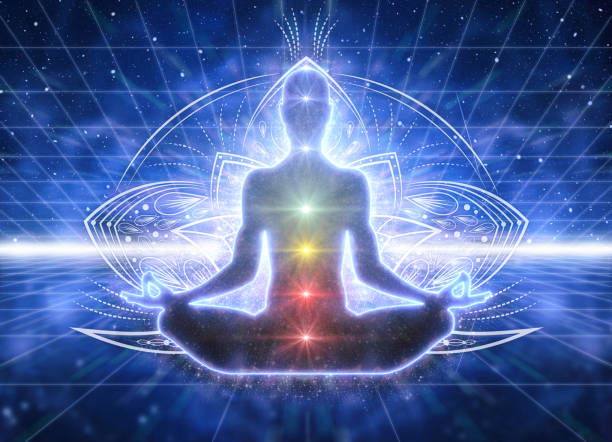Practicing Vairagya, or Abhyasa Vairagya, in daily life involves cultivating a mindset that is less attached to the transient aspects of the world. It’s about finding a balance between engaging with the world and being detached from the outcomes or the hold they have on you.
What is Abhyasa Vairagya?
In the context of Patanjali’s Yoga Sutras, specifically in Sutra 1.12, the concept of Abhyasa Vairagya is introduced as a means to attain a state of mental tranquility and inner peace.
Sutra 1.12 reads: “Abhyasa Vairagyabhyam Tannirodhah,” which can be translated to mean that the fluctuations of the mind (chitta vrittis) are restrained by practice (abhyasa) and non-attachment (vairagya)
Here, Patanjali outlines that the mind’s fluctuations, which can cause disturbances, restlessness, and emotional turmoil, can be subdued through two primary methods:
Abhyasa: This refers to the practice, the continuous effort to cultivate a focused mind. It involves consistent, dedicated practice, particularly in the context of meditation and yogic practices, to quiet the mind’s fluctuations. It’s the ongoing effort and dedication to this practice.
Vairagya: In this context, Vairagya refers to non-attachment or dispassion. It’s the state of being unattached to the outcomes of one’s practice.
It involves letting go of strong attachments to material possessions, desires, and even the outcomes of one’s efforts. It doesn’t mean avoiding responsibilities or emotions but rather not being controlled by them.

How To Practice Vairagya In Daily Life For Spiritual Progress?
Here are some ways to Practice Vairagya in daily life.
Mindfulness & Awareness
Mindfulness and awareness practices involve cultivating a state of focused attention on the present moment.
These practices are often rooted in various contemplative traditions and have gained popularity in secular contexts as well. The core idea is to bring one’s attention to the current experience without judgment, fully engaging with the present moment.
- Being In The Present: Observe and be mindful of your thoughts, emotions, and reactions without immediate judgment.
Mindfulness typically starts by paying attention to the breath, sensations within the body, or the sounds in the surrounding environment. The objective is to tether the mind to something happening in the present moment.
Mindfulness helps in understanding your attachments. Practitioners can notice the arising of desires and the accompanying emotional reactions without getting entangled in them.
By focusing on the current moment, individuals can often alleviate the stress associated with future uncertainties or past events.
This redirection of attention can contribute to a reduced attachment to future outcomes and a greater acceptance of the present as it is.
Gratitude & Contentment
- Gratitude Practice: Regularly acknowledge and appreciate the things you have. This cultivates contentment, reducing the desire for more and lessening attachment to material possessions.
This shift is fundamental to Vairagya, as it reduces the intensity of desires for more or different circumstances.
Through consistent gratitude practice, you become more aware of the abundance in your life. This awareness can lead to a reduction in the attachment to external possessions, achievements, or relationships, fostering a sense of Abhyasa Vairagya. - Contentment: This involves being satisfied with your current possessions and embracing the present moment as it is.
This acceptance aligns with the vairagya principle of detachment from the constant craving for change. It involves finding fulfillment in the current state of affairs rather than seeking it in future achievements or acquisitions.
Contentment allows individuals to appreciate the beauty in the imperfect and find peace in the present circumstances. - Simplicity: Embrace a simpler lifestyle. Decluttering your physical space and schedule can help in reducing attachment to material possessions and excessive commitments.
Acceptance & Letting Go
- Acceptance of Impermanence: Understand and accept that everything in life is transient. Things come and go, change is constant.
Acceptance entails acknowledging and recognizing the transient nature of all experiences. This recognition is crucial to Vairagya, as detachment stems from the realization that nothing in the external world is enduring. - Letting Go of Control: Acknowledge that not everything is within your control. Practice letting go of the urge to control outcomes and, instead, concentrate on your efforts and intentions.
Letting go of attachments to roles, identities, and self-image is a crucial aspect of vairagya. By releasing identification with external labels, individuals cultivate a sense of detachment from the ever-changing roles they play in society.
Acceptance involves acknowledging and embracing the current state of affairs while letting go is about releasing attachment to specific outcomes.
Together, these practices help individuals detach from the constant craving for things to be different. They foster a mindset that is less disturbed by the ups and downs of life.
Self-Reflection & Contemplation
Participating in self-reflection enables individuals to delve into the essence of the self and challenge their assumptions regarding identity.
It encourages individuals to question the workings of the egoic mind By reflecting on the egoic tendencies, individuals can loosen the grip of the ego and cultivate a more detached perspective.
Self-reflection helps individuals clarify their values and priorities, guiding them toward a more profound understanding of what truly matters. This journey can result in a decreased dependence on external circumstances for happiness.
- Journaling: Write about your thoughts, experiences, and emotions. This can help in self-reflection and understanding your attachments.
- Contemplation and Self-Inquiry: Regularly question your desires, motivations, and attachments. Ask yourself why certain things hold importance. Contemplation involves deep reflection on one’s thoughts, emotions, and desires.
Through contemplation, individuals can examine their attachments and desires, understanding the root causes and motivations behind them.
This awareness is essential for abhyasa vairagya, as it involves reducing attachment to external circumstances.
Both these practices contribute to the cultivation of equanimity, a mental state characterized by calmness and composure.
Vairagya involves maintaining equanimity in the face of life’s fluctuations. Self-reflection and contemplation help individuals develop a balanced perspective, reducing reactivity to changing circumstances.
Service & Compassion
- Service Without Selfishness: Participate in acts of kindness and service without anticipating anything in return.
This aids in diminishing attachment to personal gains. Acts of selfless service frequently entail prioritizing the needs of others over one’s own desires.
By consistently engaging in such acts, individuals gradually transcend their egoic desires and seek personal gratification. Vairagya involves detachment from the ego’s constant demands, and selfless service supports this detachment. - Compassion Towards Others: Practice empathy and understanding towards others. This can help in reducing attachment to judgments and prejudices.
Compassion entails acknowledging and empathizing with the suffering of others without being attached to the outcomes of one’s actions (nishkama karma).
Vairagya is often rooted in the understanding of the interconnectedness of all beings without being attached.
Compassion contributes to this understanding by fostering a sense of shared humanity and interconnectedness, reducing the illusion of separation between oneself and others with a detached approach.
Spiritual Practices – Yoga, Meditation & Scriptural Study
Spiritual practices, such as yoga, meditation, and the study of scriptures, are instrumental in practicing vairagya.


- Yoga involves physical postures (asanas), breath control (pranayama), and meditation.
The physical and mental discipline cultivated through yoga helps individuals develop self-control, reducing the influence of desires and attachments on the mind. - Meditation practices involve contemplation on the impermanence of all experiences. This understanding is crucial to practice Vairagya, as it encourages individuals to let go of attachments to transient phenomena and to recognize the ever-changing nature of life.
Certain meditation practices aim at transcending the Egoic mind and realizing a deeper sense of self. - Studying spiritual texts offers individuals philosophical insights into the essence of existence, the self, and the world.
This intellectual understanding can contribute to the development of Vairagya by challenging conditioned beliefs and encouraging a more dispassionate view of life.
Combining yoga, meditation, and the study of scriptures creates a holistic approach to spiritual development.
Yoga addresses the physical aspect, meditation addresses the mental aspect, and the study of scriptures addresses the intellectual and philosophical aspects. This widespread approach provides a mature foundation for Abhyasa Vairagya
Moderation & Balance
- Moderation In Enjoyments: Enjoy pleasures but in moderation. Balance is key in reducing excessive attachment to specific experiences.
- Harmonious Living: Strive for equilibrium in work, leisure, relationships, and personal time. This helps in avoiding over-attachment to any one aspect of life.
Seeking Guidance From Community Support (Satsang)
- Mentorship or Community: Seek guidance from mentors or join communities that align with your values and support your journey towards detachment.
Satsang often involves the sharing of spiritual teachings, insights, and wisdom by experienced practitioners or teachers.
Exposure to these teachings provides individuals with valuable guidance on cultivating Vairagya Abhyasa and understanding the nature of detachment.
Satsang provides an opportunity to interact with experienced practitioners or spiritual teachers who can offer guidance and mentorship. Having access to individuals who have walked the path of Vairagya can be invaluable in understanding its nuances and challenges.
Conclusion
Together, Abhyasa Vairagya, consistent practice, and non-attachment is the dual path towards calming the mind.
This combination is believed to lead to the stillness of the mind, ultimately helping individuals attain a state of inner peace, mind purification, and spiritual growth according to the yogic tradition.
Remember, practicing vairagya is a continuous process that involves consistent effort and self-awareness. It’s not about renouncing life but about engaging with it while understanding its impermanence and maintaining an inner balance and peace.
- The Namagiri Thayar Mantra – For Wisdom, Creativity & Prosperity - April 29, 2024
- Krishnashtakam – “Krishnam Vande Jagadgurum” – Lyrics & Meaning - April 4, 2024
- Karadarshanam – “Karagre Vasate Lakshmi” – Meaning & Benefits - March 26, 2024

0 Comments